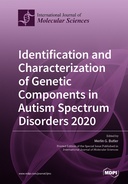Explore

Identification and Characterization of Genetic Components in Autism Spectrum Disorders 2020
0 Ungluers have
Faved this Work
Login to Fave
The Identification of the Genetic Components of Autism Spectrum Disorders 2020 will be a useful resource for laboratory and clinical scientists, translational-based researchers, primary healthcare providers and physicians, psychologists/psychiatrists, neurologists, developmental pediatricians, clinical geneticists, teachers, special educators, and caregivers involved with individuals who have autism spectrum disorders (ASD), with the goal to translate information directly to the clinical, education and home settings. Other professionals, students at all levels, and families who are interested in this important neurodevelopmental disorder will find this textbook of value by obtaining a better awareness of the causes, testing, and understanding of genetic components leading to autism, and research that may open avenues for treatment with new approaches. This textbook includes nine chapters divided into three sections (clinical, genetics, other) written by experts in the field dedicated to genetics research and clinical care, description, and treatment by generating reviews for ASD and related disorders. These chapters include information on discoveries, risk factors, causation, diagnosis, treatment, and phenotyping with characterization of genomic or genetic factors and the environment, as genetics play an important role in up to 90% of individuals with autism via over 800 currently recognized genes.
This book is included in DOAB.
Why read this book? Have your say.
You must be logged in to comment.
Rights Information
Are you the author or publisher of this work? If so, you can claim it as yours by registering as an Unglue.it rights holder.Downloads
This work has been downloaded 101 times via unglue.it ebook links.
- 101 - pdf (CC BY) at Unglue.it.
Keywords
- 15q11.2 BP1-BP2 deletion
- 22q13.3 duplication
- ASD
- assessment
- ASSR
- auditory event-related potential
- auditory steady-state response
- Autism
- Autism Spectrum Disorder
- Autism Spectrum Disorders
- autism spectrum disorders (ASDs)
- Bioinformatics
- Biology, Life Sciences
- biomarker
- broader autism phenotype
- Burnside-Butler syndrome
- CACNA1C
- Causes
- Cav1.2
- clinical decision support systems (CDSSs)
- clinical findings
- CNV
- Cognition
- dental enamel defect
- disease biomarkers
- DNA Methylation
- Environmental factors
- epigenetic factors
- ERP
- exome sequencing
- gene fusion
- Genetic
- genetic factors
- Genetics
- Genetics (non-medical)
- genomic characterization
- heterogeneity
- Human genetics
- Intellectual Disabilities
- interactomics
- Life sciences: general issues
- Mathematics & science
- medications
- metabolomics
- multiplex family
- neuropsychiatric behavior development
- pervasive developmental disorder
- Pharmacogenomics
- phenotypic subgroups stratified by ASD severity
- post-synaptic density
- protein–protein interaction
- Proteomics
- Reference, information & interdisciplinary subjects
- Research & information: general
- SHANK3
- short QT syndrome
- simplex families
- SNP
- subgroup-associated genes and biological functions
- syndromes
- Treatment
Links
DOI: 10.3390/books978-3-0365-3612-5Editions

